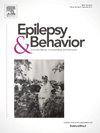Preparing adolescents and young adults with epilepsy for transitioning health care (PATH) study: The important role of age and self-efficacy
IF 2.3
3区 医学
Q2 BEHAVIORAL SCIENCES
引用次数: 0
Abstract
Background
At least 30% of youth with epilepsy will require transition from pediatric to adult neurology care. Many adolescents and young adults (AYAs) with epilepsy are inadequately prepared for health care transition, which may contribute to health care disruptions and decreased quality of life. The current study aimed to add to the growing body of literature on health care transition in epilepsy by characterizing a sample of AYAs with epilepsy and assessing the relationship between pre-existing and behaviorally modifiable factors and epilepsy-specific transition readiness.
Methods
103 AYAs (Mage = 17.56; range = 14–21; 54% female; 85% White) with epilepsy and 84 of their caregivers were enrolled from two pediatric hospitals in the United States. Participants provided sociodemographic and medical information and completed questionnaires assessing functioning, epilepsy management, and transition readiness. Data were analyzed using a two-step hierarchical multiple linear regression model with epilepsy-specific transition readiness as the outcome: 1) pre-existing factors (i.e., age, insurance, seizure severity); and 2) behaviorally modifiable factors (i.e., cognitive functioning, medication self-management, epilepsy self-efficacy).
Results
Only 44% of AYAs had discussed health care transition with their pediatric neurologist. The final model was significant, ΔF (3, 90) = 13.45, p < 0.001. Older age and greater epilepsy self-efficacy were associated with greater epilepsy-specific transition readiness.
Conclusion
AYAs with greater epilepsy self-efficacy may be better prepared for the transition from pediatric to adult neurology care. Routine assessment of epilepsy self-efficacy and transition readiness starting in early adolescence may help to identify individuals who could benefit from targeted interventions.
准备青少年和年轻成人癫痫过渡卫生保健(PATH)研究:年龄和自我效能感的重要作用
背景:至少30%的青少年癫痫患者需要从儿科转向成人神经病学治疗。许多患有癫痫的青少年和青壮年(AYAs)没有为卫生保健过渡做好充分准备,这可能导致卫生保健中断和生活质量下降。目前的研究旨在通过对患有癫痫的aya样本进行特征描述,并评估预先存在的和行为可改变的因素与癫痫特异性转变准备之间的关系,从而增加关于癫痫保健转变的文献。方法103例AYAs (Mage = 17.56;范围= 14-21;54%的女性;85%白人)癫痫患者和84名护理人员从美国两家儿科医院入选。参与者提供了社会人口学和医学信息,并完成了评估功能、癫痫管理和过渡准备程度的问卷调查。数据分析采用两步分层多元线性回归模型,以癫痫特异性转变准备程度为结果:1)预先存在的因素(即年龄、保险、癫痫发作严重程度);2)行为可改变因素(即认知功能、药物自我管理、癫痫自我效能)。结果仅有44%的asa与他们的儿科神经科医生讨论过医疗保健转变。最终模型具有显著性,ΔF (3,90) = 13.45, p <;0.001. 年龄越大,癫痫自我效能越高,癫痫特异性转变准备程度越高。结论具有较高癫痫自我效能感的儿童患儿为从小儿向成人神经内科护理的转变做好了较好的准备。从青春期早期开始对癫痫自我效能和过渡准备进行常规评估,可能有助于确定可以从有针对性的干预中受益的个体。
本文章由计算机程序翻译,如有差异,请以英文原文为准。
求助全文
约1分钟内获得全文
求助全文
来源期刊

Epilepsy & Behavior
医学-行为科学
CiteScore
5.40
自引率
15.40%
发文量
385
审稿时长
43 days
期刊介绍:
Epilepsy & Behavior is the fastest-growing international journal uniquely devoted to the rapid dissemination of the most current information available on the behavioral aspects of seizures and epilepsy.
Epilepsy & Behavior presents original peer-reviewed articles based on laboratory and clinical research. Topics are drawn from a variety of fields, including clinical neurology, neurosurgery, neuropsychiatry, neuropsychology, neurophysiology, neuropharmacology, and neuroimaging.
From September 2012 Epilepsy & Behavior stopped accepting Case Reports for publication in the journal. From this date authors who submit to Epilepsy & Behavior will be offered a transfer or asked to resubmit their Case Reports to its new sister journal, Epilepsy & Behavior Case Reports.
 求助内容:
求助内容: 应助结果提醒方式:
应助结果提醒方式:


